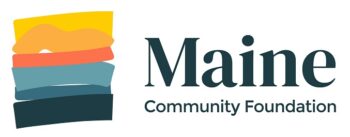In Tenants Harbor, St. George School teachers Paul Meinersmann and Amy Palmer, and seventh-grader Adrien Williams look on as sixth-grader Cecil White programs the movements of a SunFounder PiCar-V Smart Video Car Kit purchased with support from a MaineCF grant.
Michael R. Felton became superintendent of the St. George Municipal School Unit (MSU) on July 1, 2015, after the Town of St. George withdrew from a larger unit to establish its own, independent school district. Soon after establishing the MSU, community members, staff, and school board – inspired by the vision and generosity of Wick Skinner – founded the Makerspace Initiative. Paul Meinersmann, Technology and Makerspace Director, and Amy Palmer, STEAM Educator, lead the Makerspace Initiative, while Superintendent Felton works to make sure they have the resources and space to innovate, create, and engage students, staff, and community members. Together, they fielded questions for this MaineCF@35 interview.
What is Makerspace?
A Makerspace is both a thing and an idea. It is a place where people can get together to make stuff, often using a mixture of traditional tools and resources, such as paper, scissors, duct tape, and cardboard, and modern tools, including 3D printers, laser cutters, CNC (Computer Numeric Control) machines, robotics, and computers.
As an idea, a Makerspace is the belief that people often learn best when they are involved in making something that is tangible and has purpose.
When did the program start at the St. George School?
Our Makerspace started with a 3D printer that was donated by the Perloff Family Foundation in late April of 2016. With less than two months of school left in that year and no prior knowledge of 3D printing, we were able to successfully complete projects with students in the second grade (hand-drawn lobsters) and seventh grade (designed and tested the strength of different types of bridges). This experience got a lot of people excited about the potential to do more Makerspace activities and incorporate them into existing classroom plans.
The support, enthusiasm, and vision of MaineCF donor Wick Skinner and his Mainstream Fund provided the tipping point that launched the Makerspace Initiative, bringing into the realm of possibility what we had only imagined. Wick originally approached the school in the spring of 2016 to discuss innovative education ideas. He was interested in ideas that would stretch our collective imagination as to what was possible in public education.
How many students are involved?
Of the roughly 190 K-8 students at the St. George School, almost everyone has some contact with the Makerspace on a regular basis. We have both a Makerspace Director [Paul Meinersmann] and a STEAM (Science, Technology, Engineering, Art, and Math) Educator [Amy Palmer] who work with teachers and students to incorporate Makerspace activities into their classrooms.
We also facilitate after-school activities that allow students to dive deeper into Makerspace activities that interest them. Additionally, there are some students with whom we work one-on-one or in small groups at various times of the week. These are often students that benefit immensely from a more hands-on setting and who are not as well served in a traditional classroom setting.
How does the program move students from being consumers to being producers of technology?
At its core, the Makerspace reminds students (and educators!) that we are all inventors and entrepreneurs and have the power to solve problems. When a piece of a classroom saltwater tank breaks, the first step is no longer to jump online and order a part. Instead, students can create prototypes using the 3D printer, design software and – most importantly – imagination and perseverance.
Students build and program their own robots and gain a better understanding of the logic that underlies the computers and software that pervade their lives. Rather than “Google” existing information and ideas, our students use the Makerspace to create something new and reshape what already exists.
Can you provide an example or story of how the program has been a lifesaver for a particular student?
This program has been instrumental in engaging two students in particular. Both students are smart, but have challenges academically. They often disengage in class when the focus is on reading or writing. However, in the Makerspace they can create and problem-solve by doing. They meet challenges, use their brains, and feel a sense of accomplishment in a way that is not possible in the traditional classroom. The Makerspace has been key to keeping these two students engaged at school, thus opening up a future for them that was not possible before.
How does this program fit with the mission of the St. George School?
How has it transformed the school? St. George School is dedicated to the success of every student and the vitality of the Town of St. George. We focus on excellence in the areas of student achievement, school culture, shared leadership and responsibility, and meaningful learning experiences; community, by connecting students with the people, traditions, and history of St. George so they have a strong foundation to expand their view of the world; and engagement, through students and staff who are lifelong learners engaged in relevant and rigorous learning involving their families and community organizations.
The Makerspace helped us realize that anything is possible, that this school-community has the ability and resources to be exceptional and serve, challenge, and engage all of our students. For some students the Makerspace has been a lifesaver. Where they were unengaged and drifting through school in the past, now they are designing 3D models of a deer, building and programming robots that perform specific tasks, and creating their own chess boards and chess pieces. The Makerspace Initiative challenges all students more fully by requiring them to apply their creativity and intellect to solve problems, e.g., using software and the 3D printer to engineer a necessary piece for a classroom’s saltwater tank that needs to be replaced.
Makerspace has helped move all of our students from being consumers of technology to producers – and with that change comes a feeling of empowerment that is priceless.
What role has MaineCF funding played in the success of the program?
Funding provided by MaineCF via the Mainstream Fund has allowed the St. George School Makerspace to grow and adapt to opportunities and challenges. These funds first came to us in the fall of 2016, and we used them, along with matching funds raised within our community, to purchase our laser cutter. This opened up tremendous new areas for creativity and exploration by students and staff. We’ve used the laser cutter to make automatons, board games, woodblock prints, spirographs, Mother’s Day cards, various gears, and robotics parts.
Additional MaineCF funding has allowed us to purchase Sphero SPRK+ robotic balls that we use to introduce algorithmic thinking and problem-solving to students, as well as to make art and have a lot of fun. Recent funding is helping us explore a variety of tools and resources, helping us tailor what we buy to best meet needs as they arise. It also allows us to continue supporting individual students who benefit from more concentrated time in the Makerspace.
Best of all, this most recent MaineCF funding allows us to try things at which we might fail, reflect on what we have learned, and model the process of persevering through challenges that we don’t have the answers to – yet. Our students are co-pilots along the journey to figure out what is possible in public education.





